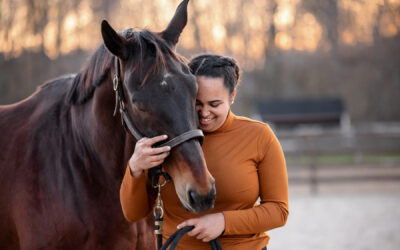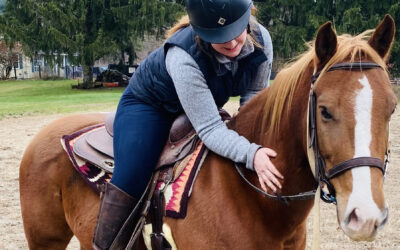Blog
The Myth of the Unadoptable Horse
In today’s equine rescue world there seems to be a widely accepted belief that a large number of horses currently living in rescue groups or sanctuaries are unadoptable. Often these horses live the rest of their lives on the property and on the dime of the non-profit and their donor base. In theory this sounds like a lovely story, but is it really the most impactful way we can help at-risk horses? The extended length of stay of an “unadoptable” horse takes up a space that could have saved the lives of countless “adoptable” horses had they had a safe place to land. By adopting out a sanctuary horse, you are giving that particular horse the chance to be loved and cared for by a new owner while simultaneously opening the door to countless other horses needing help and care. So does it really make sense to support one at-risk horse for multiple years with the same donor dollars that could have placed dozens in new homes in that same time frame? Instead, why don’t we consider examining why these horses were labeled “unadoptable” in the first place?
Common reasons for a horse being deemed unadoptable range from lameness issues, health problems, temperament problems or they are just plain old. Rescue groups/adoption agencies often give them the use of a paddock, lifelong healthcare and feed for as long as these horses will live. But, is it really necessary? If a horse is capable of living a quality life at a sanctuary, then why would it not be capable of doing the same in a private home? In fact, wouldn’t it be better for a horse with more advanced needs to be loved by a family in an adoptive home where it can receive individual attention?
First, let’s examine what an adoptable horse looks like. The definition of adoptable is a horse that is suitable or eligible for adoption. Generally, a horse is considered suitable for adoption if it has relatively safe ground manners (not dangerous to humans), and is healthy enough to live without suffering. These two factors are what delineates an adoptable horse vs. unadoptable. Is the horse likely to hurt someone on the ground and training efforts have failed to eliminate dangerous behavior? Is the horse going to suffer? The truth is, if either of these things are true about the horse, then the horse becomes a euthanasia candidate.
Veterinarians must always be involved in the euthanasia conversation. The American Association of Equine Practitioners has publicly posted widely accepted criteria for euthanasia to help guide equine veterinarians when making a euthanasia decision. The decision comes down to unmanageable pain and suffering. If a horse is so unhealthy that it is experiences ongoing suffering then it should not be in a sanctuary. Rather, the horse should be granted a humane ending. The decision whether and when to euthanize should always be made under the guidance of an equine veterinarian.
The good news is most sanctuaries in the United States are not filled with horses that are dangerous to people or live in a state of unmanageable suffering. In fact, most horses in organizations that are labeled unadoptable are simply old, not trained, have some manageable health issues or not able to be ridden.
Let’s go ahead and dispel some of the myths surrounding the mislabeled “unadoptable” horses. The untrained horses simply need some training to become adoption candidates. Old horses are not easy to adopt but they can be adopted, and therefore should be adoptable. What about the horses that have some health issues that make them ineligible for riding? Sometimes equine advocates can feel like an adopter couldn’t take care of a horse’s special needs. In fact, often these assumptions are wrong. There are adoption groups that have experienced great success placing special needs horses and companion horses. I’m not saying it is easy; but with creative marketing and a positive adoption philosophy it can definitely be done. There are adopters out there that are capable and willing to take on special needs horses. There are even some who enjoy providing extra care and feel fulfilled by providing a great home to a horse in need. Check out two ASPCA Pro webinars for great ideas and tips here and here.
In addition to benefiting individual horses, shifting to find homes for previously-deemed “unadoptable” horses opens up a whole new world for organizations. Let’s take a look at a rescue called Horses’ Haven. This fantastic adoption group in Howell, Michigan was established in 1995. This group truly identified itself as a sanctuary since inception. In 2015, they had approximately 70 horses in their care; 50 were considered sanctuary horses. They did under five adoptions a year and their 70-capacity barn was completely filled with “unadoptable” sanctuary horses. Then, something changed. They no longer wanted to say no to all the requests to help horses; but they were forced to say no as they had no space. In 2016, they decided to develop a strategy to move the sanctuary horses out of their rescue so they could begin to say yes again. Flash forward to one year later and they increased their adoptions to 36 horses! Each and every one of those horses adopted was originally considered unadoptable. How did they do it? They focused on training the horses and seeking out adopters that would tolerate some special needs. The board of directors no longer believed in the notion that sanctuary was the best place for the horses. They began to understand that if they placed these horses they could exponentially increase the number of horses they were able to help each year. The sanctuary became a legitimate and strong adoption program.
Another organization that is helping to dispel the myth of the unadoptable horse is the New Mexico Horse Rescue. In June of 2019, they placed a horse named Strawberry into a new home. What was special about Strawberry was she had been at their barn for eight years. She was a shy and introverted horse considered virtually unadoptable. However, with an increased effort by volunteers and staff to socialize and train her, suddenly her future was very bright. She even gained enough confidence to become a lesson horse in her adoptive home. Strawberry was not the only one. New Mexico Horse Rescue made a concerted effort to focus on their long timers and guess what…they placed many of them! It simply took their staff and volunteers deciding that these horses were valuable and adoptable.
Now what if half of the current sanctuaries in the U.S. did something similar in their programs? What if they decided to get creative, train the untrained, find the companion homes, change their own perspective? I’ll tell you what would happen; we would have the twice the capacity in this country to assist at-risk horses. We could help twice as many horses. In a world where adoption is one of the last considered options for acquiring a horse, don’t we need to be promoting the adoptability of ALL of our horses? If we ourselves are claiming that so many of our horse in care are unadoptable or sanctuary horses, aren’t we just re-affirming the public’s belief that we aren’t the place to go to get a horse? Instead, let’s take a long hard look at the horses in our care and really consider if they indeed are adoptable. Once we look at our own horses as adoptable, it is much easier to convince the public they should adopt them.


